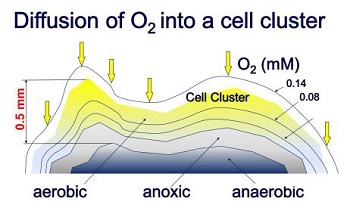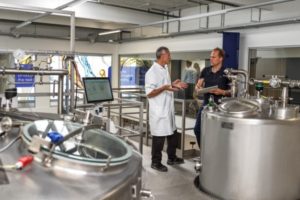MBBR Carrier Media and their Respective Diffusion Depth
The diffusion depth as an important aspect to be considered in the evaluation of removal rates and treatment performance of MBBR carriers (biofilm carriers)

The O2 removal up to the anoxic zone (Image: Mulit Umwelttechnologie)
In the sector of biological wastewater treatment, it can increasingly be observed that biofilm carriers are applied in so-called Moving Bed Biofilm Reactors (MBBR). In such systems, the carriers are being mixed inside the reactor and kept in permanent suspension. The system does not require any return sludge recirculation and hence, slowly growing microorganisms which have established on the carriers are retained in the system together with the carriers themselves. The availability of high-performance biofilm carriers, which have been developed during the recent years, is certainly one of the reasons for the increase in the application of the MBBR. This development is an outcome of multiple factors such as the research in the sector of biofilm technology, the optimized utilization of polymer technology, the process-technological application up to the evaluation of operating results of long-term-operating large-scale plants.
A significant reason for the optimized product development in this field of application arises from the following question:
“Which biological removal rate can be attained by using the product in operation, and how can it be realized to achieve constant removal rates and process stability?”
Even the decision maker has to ask his- or herself this question and needs to receive reliable design data for being able to come to the correct conclusion:
The surface area which has been indicated in the past by various manufacturers, regardless of whether they referred to the protected or the total calculated surface area, respectively, is not the only characteristic which is crucial for evaluating the desired or required biological removal rate for the respective application. The specific surface area is only a comparative figure used in the competition between the plastics suppliers. This comparative figure is mostly calculated by means of geometrically defined, plain and poreless plastic parts, based on new uncolonized carriers coming directly from the production process. With regard to biological wastewater treatment in practice, the indication of a “theoretical” surface area is helpful only to a certain extent and can become problematic for the decision maker. Hence, the question concerning the biological removal performance in Anammox, denitrification and nitrification process application or COD-removal, respectively, cannot be answered reliably by indicating the surface area only.
It is in turn crucial how much “active” biomass can establish on the carrier media and hence, which efficiency and removal rate can be attained. It is essential that the biomass is permanently fixed on the carrier media in order to provide an optimal habitat for the required microorganisms. Any biomass that is quickly being sheared off or rinsed off during the movement process (Moving Bed) gives no chance to slowly growing organisms like nitrifying or Anammox-bacteria. It hence is required to establish the biofilm permanently.
A large surface area or a huge quantity of biomass, respectively, is not beneficial as long as the microorganisms are not sufficiently supplied with nutrients. Thereby, an important role is played by the shape or geometry of the numerous carriers which are available on the market. Here as well, not the virgin and unused condition of the carrier media but the biomass that will establish later on during the operation in the sewage treatment plant is crucial. The biomass must stringently be “active” to attain optimal biological removal rates. A biomass which has died off due to the lack of nutrients is not useful and does not contribute to the desired metabolic processes.
The designation “active biomass” shall mean that all microorganisms within the biomass are sufficiently supplied with essential nitrogen (N), phosphorus (P), with the wastewater pollutants to be metabolized, and with oxygen (if required). The so called supply channel of the aforementioned substrates and oxygen is the diffusion depth. For the supply of organisms inside of the biomass (or biofilms), the reaction time-dependent diffusion depth is limited to 0.2 – 0.5 mm.
Subsequently, the organisms which are located in the lower layers of the biomass are not sufficiently supplied with substrates and die off consequently. As a result, the layer below the depth of 0.5 mm does not contribute to the metabolism process (removal rate) and in turn must not be considered for indicating the removal efficiency of the respective carrier. Actually, the died-off biomass can even have a negative impact on the active biomass/biofilms above it, due to fouling processes and H2S-generation.
The optimal supply of the biofilms with substrates and oxygen is reached at a layer thickness/depth of up to approx. 0.5 mm.
Hence, the task to be fulfilled by research and development is, among others, to create a surface which allows for the growth of biofilms having a max. thickness of up to 0.5 mm for ensuring an appropriate diffusion.
If the biofilm establishes on an even/plain or smooth surface, it tends to be quickly flushed off and in an uncontrolled way or, respectively, grows on to a thick and uncontrolled biofilm containing inactive biomass in the lower layers. Both cases would be of negative benefit.
The task is the protection of the active biomass up to a layer thickness of approx. 0.5 mm (ideal compliance with the optimal diffusion process) on the one hand and the adherence to the aforementioned layer thickness on the other hand; avoiding excessive growth and too thick layers. Hence, by means of the carrier configuration, it must be managed to create the opportunity to shear off/remove the excess sludge and hence, to maintain a biofilm thickness of up to 0.5 mm. The thickness of the carrier disc is crucial for active biofilms.
Hence, all carriers which are currently available on the market, regardless of whether hollow body carriers, tube- or helical-shaped or sponge carrier configuration, respectively, are inadequate and not able to fulfill this requirement.
The ideal requirements can be fulfilled by the use of thin, disc-shaped and porous carriers, whereas an optimal and active biofilm establishes inside of the pores and any excess sludge is being removed by shear forces. The shear forces occur when the disc surfaces are contacting each other due to the movement of the carriers in the wastewater (reaction tank).
When using tubular carriers, it is not possible to benefit from the shear forces effect in the inner zones of the carriers, which has been proven to be a significant disadvantage.
When using stable, porous, disc-shaped carriers having a thickness of 1.0 – 1.2 mm, the active biofilm can establish inside of the pores and hence, the supply with substrates can be effected from both sides of the carrier.
Another requirement to be fulfilled is the maximum reduction of wear. In most cases, the reason for the occurrence of wear and abrasion of carriers is the kinetic energy, i.e. the energy which is required for slowing-down a body which is moved in the water. Any non-elastic, large and heavy tubular/hollow body carriers which possibly even contain a huge amount of dead biomass, show a disadvantageous kinetic behavior compared to lightweight, flexible disc-shaped carriers. Flexible “buffer zones” in the plastic material maximally reduce the wear. Additionally, the biofilm serves as lubricant layer.
In order to specify the carrier media requirement as well as the removal rates (not the surface area), the determination of the wastewater design temperature is required besides the general design data and hence, is indispensable for a comparison with competitors. Consequently, the water design temperature plays an important role in calculating the carrier media requirement. Anyone who wants to draw a comparison must carry out the latter under similar (equal) preconditions and hence while considering the same design temperature.
Only provided that the essential requirements are fulfilled, the design evidence including removal rates is available and large-scale references can be presented by the carrier media supplier, only then the risk can be assessed and be borne by the decision-maker.
To summarize, it can be stated that the biological removal rate which is calculated by the respective manufacturer – and not solely the surface area – serves to determine the removal target. During the plant operation, an optimal carrier geometry is a stringent requirement for appropriately meeting the biological demands and hence to ensure the optimal development of the biofilm.
Source: Multi Umwelttechnologie AG






